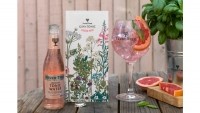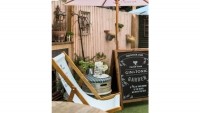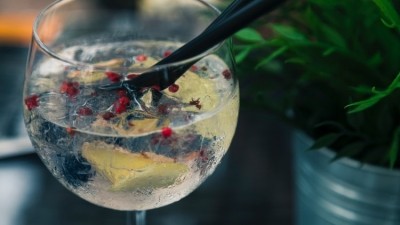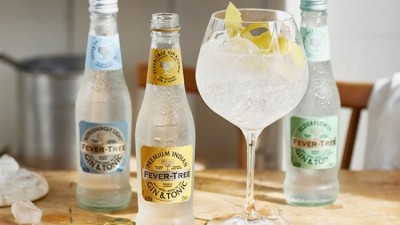In association with Fever-Tree
Why creating the perfect G&T garden can push profits

Brits knocked back 38% more gin in the 12 months to June 2018 than they did during the previous year, recent Wine & Spirits Trade Association figures show. The same report suggests gin sales have doubled in the past five years, accounting for a £1.6bn industry between 2017 and 2018.
There is no argument, these are impressive figures, yet it gets better. A poll by YouGov revealed gin is officially the nation’s favourite spirit, accounting for 29% of the vote, putting the spirit four percentage points ahead of runner-up whisky.
However, as you might expect, these favourable figures don’t stop at gin, with its perfect accompaniment tonic taking much of the spotlight too. “According to a recent consumer survey, we found 91% of people chose G&T as the nation’s most popular long drink,” says Charles Root, marketing controller at premium tonic producer Fever-Tree. These statistics beg the question: how can opportunistic operators profiteer from the spirit’s rise in popularity?
Creating tailored experiences
One strategy Fever-Tree is pursuing is creating tailored experiences with gin and tonic in Britain’s pub gardens. They are responding to a consumer craving for artisanal experiences. In recent years, craft gin has become as much a part of the pub conversation as craft beer, with an estimated 315 distilleries countrywide responding to consumer demand for artisanal gin that is markedly different from the products on the supermarket shelves.
You may not be familiar with the term ‘gin and tonic garden’, but the concept is proving to be an unstoppable sales force when it comes to the presentation of G&T in imaginative
new ways. The term was coined last year in The Morning Advertiser (MA) in partnership with Fever-Tree to describe the culture of pubs using their outdoor spaces by creating gin drinking destinations.
Gin and tonic lends itself to verdant outdoor settings. There’s an obvious natural connection between gardens and gin: most good gins are infused with botanicals traditionally found in the garden, such as cardamom, angelica root and coriander. Alongside this, the G&T’s refreshing palate suits the summer season when drinkers desire lighter alternatives.
While creating a gin and tonic garden may sound like an enjoyable (dare we say frivolous?) pub project, it is important to remember that such gardens must have the correct atmosphere and products in order to increase sales. Crucially, the environment and drinks must feel authentic; they must present an experience that is somewhere between drinking a gin and tonic in your own back garden, and an elevated experience of luxury, reminiscent of drinking a G&T on holiday.
Once the right garden is in place, it may be fair to expect a dramatic sales surge as drinkers flock to sample the drinking experience, especially if the weather is on your side. Fever-Tree’s seasonal gin concept experimentation, it sppears, is spreading. “I am projecting that during the summer there will be at least a 10-15% increase in sales when the Gin Hut is open,” says James Karran, founder of Cardiff’s Gin Hut concept at the St Canna’s Alehouse.
Working on gin garden concepts
While pubs countrywide are beginning their summer gin garden concepts, Fever-Tree is preparing to launch a full-scale marketing campaign around the concept. Following the launch of its campaign in 2018, the drinks company is now working with 250 British pubs in 2019 to create Fever-Tree Gin and Tonic Gardens in pubs all around the country.
Operators not involved in the campaign are encouraged to get in touch with Fever-Tree to collaborate on a drinks menu to increase summer sales of G&Ts. “We will create a bespoke gin and tonic menu tailored to the outlet’s gin range and provide 60 copies free of charge,” says Root. “Fever-Tree G&T menus are proven to increase premium gin sales by 135% and overall gin and tonic sales by 129%.”
But it’s not only publicans that can reap the commercial benefits of gin gardens, insists Shaun Ward, founder of Ludlow Gin, a brand that has increased revenue dramatically by being involved in on-trade pop-ups. “We help a wide range of customers from dedicated wedding venues to pubs throughout the West Midlands and we’ve found that dedicated external gin bars with point of sale helps improve sales dramatically,” Ward tells MA.
“We’ve worked with a number of venues that have used quirky bars like horse boxes and even fire engines, all to create something that makes them stand out from the crowd. Subtle lighting, architectural features, point of sale such as posters, wider branding – it’s easy to create something striking and unique.”
The common thread between all good gin and tonic gardens is that no two will ever look the same. While some employ elaborate props to create a lively atmosphere, others have a more functional look and feel better suited to large groups and post-work drinkers.
“Choose a colour scheme that suits your business and environment,” says Root. “Use different varieties of plants, shapes and sizes to give texture, contrast and structure. Some other key elements to a great gin and tonic garden are botanical herbs, outdoor seating, shelter from the sun, specialist summer drink menus and, preferably, an outside bar.”
For inspiration on how to build a gin garden, visit www.gardens.fever-tree.com, which also enables consumers to locate their nearest Fever-Tree gin and tonic garden. Fever-Tree has highlighted a couple of case studies ahead of the season to inspire other publicans to build their own gardens.
Two of the pubs involved, the Alwyne Castle in Highbury, north London, and the Shibden Mill Inn in Halifax, West Yorkshire, have been highlighted by Fever-Tree as G&T Garden successes.
Perfect planting
It’s important to make your gin and tonic garden fit the surrounding environment, without it seeming gawdy or excessive. Think hard about the types of plants that will fit, so the space becomes the best in your pub’s area for a relaxing drink.
“With competition between pubs at an all-time high, it is essential for pubs to find ways of differentiating themselves from their neighbours,” says Fever-Tree marketing controller Charles Root. “That’s why we are providing each pub fitted with a Fever-Tree Gin and Tonic Garden with Fever-Tree Garnish Pots, to provide more ‘green’ and give off amazing smells that will give consumers the sensory experience of a physic garden.”
For additional layers of colour, Root adds: “It is the ideal time to plant up summer bedding plants, for glorious displays throughout the season. They are ideal for brightening up a patio, deck, balcony or just a dull spot in a border.
“Choose a colour scheme that suits your business and environment, but use different varieties of plants, shapes, and sizes to give texture, contrast and structure.”
Going above and beyond
The Alwyne features outdoor table tennis and a terrace suitable for 300 people, while the Shibden is more intimate. The pub won the title of Yorkshire’s Favourite Pub in a consumer survey, and has ornate 17th-century features Fever-Tree hopes to incorporate into the gin and tonic garden. “We want to celebrate this amazing pub by giving them the tools to go above and beyond for consumers,” says Root.
“For us, it’s all about creating an experience,” says James Karran of the St Canna’s Alehouse in Cardiff. “In our Gin Hut, customers even have to hand the gin they want to the bar person, as some of the shelves are out of reach from behind the bar! The customer is involved. It’s engaging and becomes about more than the drink itself (although it is that too).”
But not all experiences need to be boundary-pushing. It’s also important to replicate the level of service traditionally found in pubs in outdoor settings, says Cailtin Heaton of the Shibden Mill Inn. “It is important that glassware and presentation isn’t compromised by alfresco service – our gin drinkers are discerning customers,” she says, “who pay for a very image-led product where taste and style carry equal weight.”
While it’s common sense that bars must produce high-quality drinks to lure the crowds, there are more specific markers to follow to increase the likelihood of sales success. The provenance of gin is as important as the taste, for example, as consumers become more connected to the storytelling behind their drinks. This is also true for premium mixers and Fever-Tree has travelled far and wide to source best-quality ingredients for its mixers.
Part of that storytelling is conveyed by bartenders who know their gins inside out, and have a dynamic selection of drinks on offer. “Sticking a sign up in the beer garden saying ‘gin and tonic garden’ and having Hendrick’s on sale alongside Bombay Sapphire won’t do,” says Karran. “We champion Welsh produce, primarily from small producers.
“People love the variety of flavours that can be combined to create a beverage that feels like ‘your own’ drink. We don’t have a set menu of gins to go with certain mixers and botanicals, instead we have them all on display and say to the customer, ‘what takes your fancy?’”
In terms of the serves, Karran acknowledges the need for gin and tonic “go-to combos” to please habitual consumers.
Marmalade gin with chocolate
For such guests, it’s important to serve a classic gin and tonic garnished with lime or cucumber, but in the case of Karran’s Gin Hut, the outdoor space has provided the opportunity to show off “more uncommon combinations that customers have discovered taste amazing, for example a marmalade gin with dark chocolate shavings (who doesn’t love a chocolate orange?).
“Championing local produce is important to us, so choosing Masons Yorkshire Gin was an obvious choice,” explains Caitlin Heaton from the Shibden Inn, who says the pub’s drinks menu – which features 35 gins and eight tonics created by Fever-Tree – is “creative and quirky”.
An alternative strategy to increase sales is to offer drinks that are already selling well in the off-trade. Charles Root explains: “We have just launched Fever-Tree Cucumber Tonic Water in the on-trade, based on its monumental success in the off-trade. Where possible
in Fever-Tree gin and tonic gardens throughout the summer, we will be encouraging consumers to try a summer serve of Fever-Tree Cucumber Tonic Water, Caorunn, cucumber ribbon, ice and a mint sprig.”
Above all else, the value of a gin and tonic garden is the opportunity it provides to use a pub’s outdoor space that may otherwise be going unused.
Even minute courtyard spaces can be rethought to provide ample earning opportunities for publicans seeking alternative revenue streams, while offering a new value add for customers at the same time.
For more information on Fever-Tree’s summer pub gardens projects, to request a bespoke gin and tonic menu for your pub or to view a comprehensive list of pubs involved, visit www.gardens.fever-tree.com.
Fantastic furnishings
Authenticity can be put at risk if gardens feel too highly designed, especially in a pub setting. Charles Root offers simple advice: “Beautiful pub gardens deserve beautiful garden assets.”
For inspiration, look up the hashtag #FeverTreeGardens on Twitter and Instagram to see how participating Fever-Tree Gin & Tonic Gardens have been designed.
“We are providing our Fever-Tree Garden kits to all 250 publicans so that they stand out from the competition, and to ensure that publicans can create the perfect environment for sipping a Fever-Tree G&T in the sun,” says Charles Root from the tonic brand.
Pubs involved with Fever-Tree’s campaign will display a Fever-Tree Gin & Tonic Garden sign, a Fever-Tree Gin & Tonic Garden outdoor kit, comprising eight parasols, six deck chairs and 15 branded herb pots.
Even though all garden kits have been allocated, Fever-Tree’s bespoke gin and tonic menus are free to order from the brand and will add a splash of colour to any gin garden.








